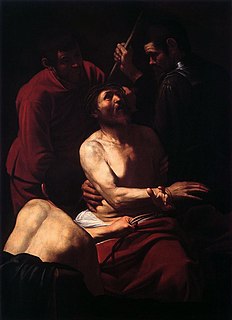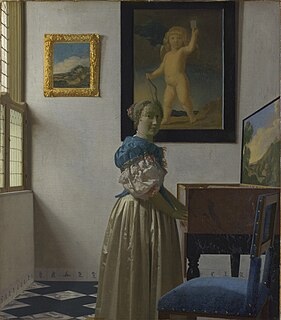The Crowning with Thorns refers to the Crown of Thorns being placed on the head of Jesus, and is a common subject in art, examples including:

Michelangelo Merisida Caravaggio, known as Caravaggio, was an Lombard painter active in Rome for most of his artistic life. During the final four years of his life he moved between Naples, Malta, and Sicily until his death. His paintings have been characterized by art critics as combining a realistic observation of the human state, both physical and emotional, with a dramatic use of lighting, which had a formative influence on Baroque painting.

The Kunsthistorisches Museum is an art museum in Vienna, Austria. Housed in its festive palatial building on Ringstraße, it is crowned with an octagonal dome. The term Kunsthistorisches Museum applies to both the institution and the main building. It is the largest art museum in the country and one of the most important museums worldwide.

The Crucifixion of Saint Peter is a work by Michelangelo Merisi da Caravaggio, painted in 1601 for the Cerasi Chapel of Santa Maria del Popolo in Rome. Across the chapel is a second Caravaggio work depicting the Conversion of Saint Paul on the Road to Damascus (1601). On the altar between the two is the Assumption of the Virgin Mary by Annibale Carracci.

The Fortune Teller is a painting by Italian Baroque artist Michelangelo Merisi da Caravaggio. It exists in two versions, both by Caravaggio, the first from c. 1594, the second from c. 1595. The dates in both cases are disputed.

The Adoration of the Shepherds is an oil on canvas painting by the Italian artist Michelangelo Merisi, commonly known as Caravaggio. The Adoration of the Shepherds measures 83.07 x 123.62 in. It was commissioned for the Capuchin Franciscans and was painted in Messina for the Church of Santa Maria degli Angeli in 1609 just one year before the artist's death. It is now in the Interdisciplinary Regional Museum of Messina.

Saint Catherine of Alexandria is an oil painting by the Italian Baroque master Caravaggio, painted from 1598-1599. It is part of the Thyssen-Bornemisza Collection of Madrid.

The Cardsharps is a painting by the Italian Baroque artist Michelangelo Merisi da Caravaggio. The original is generally agreed to be the work acquired by the Kimbell Art Museum in 1987, although Caravaggio may have painted more than one version.

The Musicians or Concert of Youths is a painting by the Italian Baroque master Michelangelo Merisi da Caravaggio (1571–1610). It is held in the Metropolitan Museum of Art, New York, where it has been since 1952. It underwent extensive restoration in 1983. During the COVID-19 pandemic, the museum began a skylight replacement project that resulted in gallery closures, in response the Met loaned major works from the European collection, including 'The Musicians', to Qagoma in an exhibition titled ‘European Masterpieces’.

Jupiter, Neptune and Pluto is a painting by Italian Baroque master Michelangelo Merisi da Caravaggio. It is located in the Villa Aurora, the former hunting lodge of the erstwhile Villa Ludovisi, Rome. It is unusually painted in oils on plaster and hence it is not a fresco, although it is sometimes (incorrectly) referred to as such. Oil painting is normally on canvas or, less frequently, on wood.
John the Baptist was the subject of at least eight paintings by the Italian Baroque artist Michelangelo Merisi da Caravaggio (1571–1610).

Christ on the Mount of Olives (1604-1606) was a painting by Michelangelo Merisi da Caravaggio, formerly in the Kaiser Friedrich Museum painting gallery, Berlin, but destroyed in 1945.

The Crowning with Thorns was the subject of two paintings by the Italian master Caravaggio. The first version, dated to around 1604–1605, is now in the Cassa di Risparmi e Depositi of Palazzo degli Alberti, Prato (Tuscany). The attribution to Caravaggio is disputed.

The Crowning with Thorns is a painting by the Italian painter Michelangelo Merisi da Caravaggio. Made probably in 1602/1604 or possibly around 1607, it is now located in the Kunsthistorisches Museum, Vienna. It was bought in Rome by the Imperial ambassador, Baron Ludwig von Lebzelter in 1809, but did not arrive in Vienna until 1816.

Bartolomeo Manfredi was an Italian painter, a leading member of the Caravaggisti of the early 17th century.

The National Gallery is the primary British national public art gallery, sited on Trafalgar Square, in central London. It is home to one of the world's greatest collections of Western European paintings. Founded in 1824, from an initial purchase of 36 paintings by the British Government, its collections have since grown to about 2,300 paintings by roughly 750 artists dating from the mid-13th century to 1900, most of which are on display. This page lists some of the highlights of the collection.
The Raising of Lazarus is a Christian miracle narrative, concerning Lazarus of Bethany.

Italian Baroque art is a term that is used here to refer to Italian painting and sculpture in the Baroque manner executed over a period that extended from the late sixteenth to the mid eighteenth centuries.

Pietà is a c. 1600 oil on canvas painting by Annibale Carracci, the earliest surviving work by him on the subject, which was commissioned by Odoardo Farnese. It moved from Rome to Parma to Naples as part of the Farnese collection and is now in the National Museum of Capodimonte in Naples. It is one of many 16th century Bolognese paintings dedicated to the theme of the Pietà, and it is counted among Carracci's masterpieces.